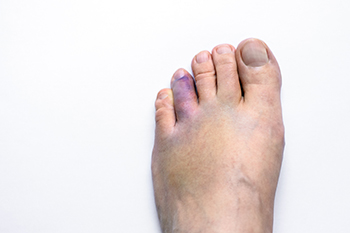Connect With Us
Blog
Items filtered by date: May 2025
Heel Pain in the Morning?
Have I Fractured My Toe?

A toe fracture is a break in one or more of the bones in the toes, often caused by direct trauma such as stubbing the toe or dropping a heavy object on the foot. Repeated stress or overuse can also lead to a fracture, especially in active individuals. Symptoms may include pain, swelling, bruising, and difficulty walking or bearing weight on the affected foot. In some cases, the toe may appear misaligned or deformed. Diagnosis is usually made through a physical examination and confirmed with imaging studies, like an X-ray. Prompt recognition of a toe fracture is important for proper healing. If you have symptoms of a broken toe, it is strongly suggested that you make an immediate appointment with a podiatrist who can offer effective treatment solutions, supporting a quicker return to normal activity and long-term foot health.
Broken toes may cause a lot of pain and should be treated as soon as possible. If you have any concerns about your feet, contact Darlyne Cange, DPM from Cange Podiatry, DPM, PA. Our doctor will treat your foot and ankle needs.
What Is a Broken Toe?
A broken toe occurs when one or more of the toe bones of the foot are broken after an injury. Injuries such as stubbing your toe or dropping a heavy object on it may cause a toe fracture.
Symptoms of a Broken Toe
- Swelling
- Pain (with/without wearing shoes)
- Stiffness
- Nail Injury
Although the injured toe should be monitored daily, it is especially important to have a podiatrist look at your toe if you have severe symptoms. Some of these symptoms include worsening or new pain that is not relieved with medication, sores, redness, or open wounds near the toe.
If you have any questions please feel free to contact our offices located in Glen Burnie and Ellicott City, MD . We offer the newest diagnostic tools and technology to treat your foot and ankle needs.
Why Feet Cramp During Sleep

Foot cramps that strike during sleep can be sudden, painful, and hard to ignore. They often affect the arch or toes and may last just a few seconds or several minutes. These cramps can be caused by dehydration, low mineral levels, poor circulation, or muscle fatigue from daytime activity. Sleeping with feet pointed or in a tight position may also trigger cramping. Stretching your feet and calves before bed, staying well hydrated, and wearing loose socks at night may help prevent episodes. Gently massaging or flexing the foot can ease the pain when a cramp occurs. If cramps become frequent or repeatedly interfere with sleep, it is suggested you see a podiatrist for appropriate treatment.
Foot Pain
Foot pain can be extremely painful and debilitating. If you have a foot pain, consult with Darlyne Cange, DPM from Cange Podiatry, DPM, PA. Our doctor will assess your condition and provide you with quality foot and ankle treatment.
Causes
Foot pain is a very broad condition that could be caused by one or more ailments. The most common include:
- Bunions
- Hammertoes
- Plantar Fasciitis
- Bone Spurs
- Corns
- Tarsal Tunnel Syndrome
- Ingrown Toenails
- Arthritis (such as Gout, Rheumatoid, and Osteoarthritis)
- Flat Feet
- Injury (from stress fractures, broken toe, foot, ankle, Achilles tendon ruptures, and sprains)
- And more
Diagnosis
To figure out the cause of foot pain, podiatrists utilize several different methods. This can range from simple visual inspections and sensation tests to X-rays and MRI scans. Prior medical history, family medical history, and any recent physical traumatic events will all be taken into consideration for a proper diagnosis.
Treatment
Treatment depends upon the cause of the foot pain. Whether it is resting, staying off the foot, or having surgery; podiatrists have a number of treatment options available for foot pain.
If you have any questions, please feel free to contact our offices located in Glen Burnie and Ellicott City, MD . We offer the newest diagnostic and treatment technologies for all your foot care needs.
Surgery Options for Plantar Fasciitis

Chronic heel pain from plantar fasciitis can make completing daily activities difficult, and, when other treatments fail to provide relief, surgery becomes an option. Plantar fasciitis surgery involves releasing the tight ligament that runs from the toes to the heel, which helps to ease pressure and promote healing. A podiatrist may recommend a plantar fasciotomy, where the fascia is carefully detached from the heel bone, or a plantar fasciectomy, where damaged tissue is removed. Surgery for plantar fasciitis can be performed as an open procedure with a small incision or endoscopically using a camera and smaller openings, typically resulting in faster recovery. Most patients can expect improved foot function after healing, although recovery times vary depending on the surgical method. A podiatrist will carefully evaluate health conditions like diabetes or nerve issues before recommending surgery. The goal is to reduce heel pain, restore mobility, and prevent long-term foot complications. If you have heel pain that may be the result of plantar fasciitis, it is suggested that you schedule an appointment with a podiatrist for appropriate treatment, which may include surgery.
Foot surgery is sometimes necessary to treat a foot ailment. To learn more, contact Darlyne Cange, DPM of Cange Podiatry, DPM, PA. Our doctor will assist you with all of your foot and ankle needs.
When Is Surgery Necessary?
Foot and ankle surgery is generally reserved for cases in which less invasive, conservative procedures have failed to alleviate the problem. Some of the cases in which surgery may be necessary include:
- Removing foot deformities like bunions and bone spurs
- Severe arthritis that has caused bone issues
- Cosmetic reconstruction
What Types of Surgery Are There?
The type of surgery you receive will depend on the nature of the problem you have. Some of the possible surgeries include:
- Bunionectomy for painful bunions
- Surgical fusion for realignment of bones
- Neuropathy decompression surgery to treat nerve damage
Benefits of Surgery
Although surgery is usually a last resort, it can provide more complete pain relief compared to non-surgical methods and may allow you to finally resume full activity.
Surgical techniques have also become increasingly sophisticated. Techniques like endoscopic surgery allow for smaller incisions and faster recovery times.
If you have any questions, please feel free to contact our offices located in Glen Burnie and Ellicott City, MD . We offer the newest diagnostic and treatment technologies for all your foot care needs.
Definition and Causes of Shuffling Gait

A shuffling gait is a walking pattern where a person takes small, dragging steps without lifting the feet fully off the ground. This abnormal gait can indicate underlying health conditions and often suggests issues with balance, coordination, or muscle control. One possible cause is ataxia, a neurological condition that impairs coordination and makes smooth walking difficult. Ataxia may result from damage to the cerebellum or other parts of the nervous system. Another related condition is foot drop, where weakness or paralysis in the muscles that lift the front of the foot causes dragging during walking. This can stem from nerve injuries or disorders affecting the muscles or spine. Identifying the cause of a shuffling gait is essential for effective treatment, improved mobility, and prevention of further complications. If you have a shuffling gait, it is suggested that you are under the care of a podiatrist who can help you to monitor this condition.
When dealing with systemic disease of the feet, it is extremely important to check the affected areas routinely so that any additional problems are caught quickly. If you have any concerns about your feet and ankles contact Darlyne Cange, DPM from Cange Podiatry, DPM, PA. Our doctor will assist you with all of your podiatric needs.
Systemic Diseases of the Feet
Systemic diseases affect the whole body, and symptoms usually are displayed in the feet. This condition can make a patient’s ability to walk unbearable. Systemic diseases include gout, diabetes mellitus, neurological disorders, and arthritis.
Gout – is caused by an excess of uric acid in the body. Common symptoms include pain, inflammation, and redness at the metatarsal/phalangeal joint of the base big toe. Gout can be treated by NSAIDs to relieve pain and inflammation, and other drugs that lower the acid levels in the body.
Diabetes mellitus – is an increase in the level of blood sugar that the body cannot counteract with its own insulin. Failure to produce enough insulin is a factor in Diabetes.
Diabetes of the Feet
Diabetic Neuropathy – may lead to damaged nerves and affect the feet through numbness and loss of sensation.
Peripheral Vascular Disease – can restrict the blood flow to the feet, and often times lead to amputation of the feet.
If you have any questions please contact our offices located in Glen Burnie and Ellicott City, MD . We offer the newest diagnostic and treatment technologies for all your foot and ankle needs.

